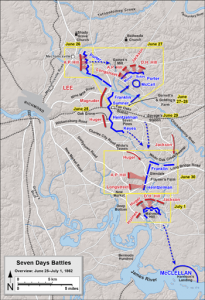The UCLA Center for the Liberal Arts and Free Institutions (CLAFI) has inaugurated a five-year lecture series on the Civil War in connection with the sesquicentennial. They plan to sponsor at least two lectures each year, with the lecturers concentrating on events of the corresponding year of the Civil War. The inaugural lecture was by Daniel Walker Howe, on the secession crisis of 1861. One unusual feature of our series is that each lecturer also participates in a two-hour Saturday morning seminar with up to twenty people, on readings selected by the lecturer. Both the lectures and the seminars are free and open to all, but because of the size capacity, advance registration is required for the seminars. Continue reading
Meeting of November 27, 2012
Death and The Civil War, Part 2
From acclaimed filmmaker Ric Burns, based on Drew Faust’s groundbreaking book, This Republic of Suffering, this film tracks the increasingly lethal arc of the war from its opening, through the chaos of Shiloh, and the following major battles which left an American landscape littered with the bodies of hundreds of thousands of soldiers, many unburied, most unidentified. The staggering casualties brought death to the American experience as never before—permanently altering the character of the republic, the psyche of the American people, and posing challenges for which there were no ready answers when the war began.
Quiz for January 29, 2013
Based on “Death and The Civil War, Part 2″
Q#1 – Did either the North or South have a system for keeping track of military personnel records? Continue reading
Meeting of October 30, 2012
Death and The Civil War, Part 1
From acclaimed filmmaker Ric Burns, based on Drew Faust’s groundbreaking book, This Republic of Suffering, this film tracks the increasingly lethal arc of the war from its opening, through the chaos of Shiloh, and the following major battles which left an American landscape littered with the bodies of hundreds of thousands of soldiers, many unburied, most unidentified. The staggering casualties brought death to the American experience as never before—permanently altering the character of the republic, the psyche of the American people, and posing challenges for which there were no ready answers when the war began.
Quiz for November 27, 2012
Based on “Death and The Civil War, Part 1″
Q#1 – Who made the movie Death and The Civil War? Continue reading
Quiz for October 30, 2012
Based on “Benjamin Franklin Butler, Lincoln’s Conundrum” by Tom Lubas
Q#1 – Where was Benjamin Butler born? Continue reading
Meeting of September 25, 2012
Tom Lubas on “Benjamin Franklin Butler, Lincoln’s Conundrum”
No further information is available.
Meeting of August 25, 2012
Hal Jespersen on the “Seven Days Battles”
In the Peninsula Campaign of 1862, Maj. Gen. George B. McClellan landed his Army of the Potomac at Fort Monroe, Virginia, and slowly advanced up the Virginia Peninsula in an attempt to capture the Confederate capital of Richmond. At the indecisive Battle of Seven Pines (Fair Oaks), the Confederate commander, Gen. Joseph E. Johnston, was severely wounded and soon replaced with Gen. Robert E. Lee. In late June, Lee launched a series of attacks against McClellan that have come to be known as the Seven Days Battles, including the battles of Mechanicsville, Gaines’s Mill, Glendale, Malvern Hill, and a few other (comparatively) minor engagements. Some historians describe the Seven Days as a campaign, others as a lengthy battle with daily engagements. If you subscribe to the latter view, the Seven Days ranks behind Gettysburg as the second bloodiest battle of the war, with approximately 36,000 casualties. Hal gave a brief overview of the initial movements and battles in the Peninsula Campaign, and then described each of the Seven Days in detail. He discussed the strategic importance of the campaign and gave his opinions on the effectiveness (or lack thereof) of the two opposing commanders. Continue reading
Quiz for September 25, 2012
Based on “The Seven Days Battles” by Hal Jespersen
Q#1 – On what date did the Seven Days Battle begin? Continue reading
Meeting of July 31, 2012
Tom McMahon on “What Sank The Confederate Submarine, The Hunley”
Tom McMahon presented a video on the scientific evidence of what sank the Confederate submarine, the Hunley.

